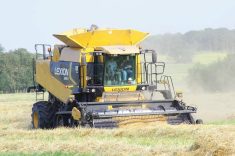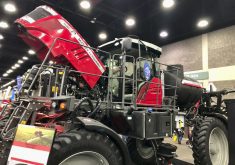Canadian farmers are expressing concern about the possibility of their access to AM radio disappearing.
Ford, which has been Canada’s best-selling auto brand since 2009, has stated it plans to stop putting AM radios in non-commercial vehicles by 2024.
The automaker’s decision follows those of companies such as Tesla, Mazda and Volkswagen, which have removed AM receivers from their electric vehicle (EV) lines, citing electromagnetic interference the EV drivetrain can create with the AM signal.
Read Also

U.S. CPC sees 75 per cent chance of La Niña transition by early 2026
La Niña continues to persist, with a 75 per cent chance of a transition to ENSO-neutral conditions likely between January and March, the U.S. Climate Prediction Center said on Thursday.
Many rural areas and farming communities are too far from population centres to catch FM radio — making AM the only broadcast media connection for market reports, weather reports and emergency updates.
Representatives from Kubota, John Deere and Stellantis — the parent company of brands such as Chrysler, Jeep and Ram — all said in emailed statements they do not have plans to phase out AM radio in their vehicles.
But even if farming vehicles retain the AM dial, decisions like Ford’s will likely have ripple effects in rural areas.
“There’s a chain of events, of course,” said Darrin Qualman, director of climate crisis policy and action for the National Farmers Union (NFU). “If the automakers phase out the AM in their cars, then it’ll make it more likely that the radio stations will phase out AM broadcasting.
“The way that farmers and rural people are affected isn’t because they end up with the cars that don’t have the AM radios, it’s because the lack of AM radios in cars leads to the shutdown of the AM signals.”
Shifting to newer technology such as internet streaming or satellite radio would not be possible for many farmers, he added.
“Tractors, unlike cars, have a very long lifespan. Farmers keep tractors for 20, 30, 40 years or more, and they are not going to have the latest radio technology.”
Canadian Federation of Agriculture (CFA) president Keith Currie said any new tech would not be able to match AM radio’s universality.
“Can you find certain things? Yes, like sporting events, you can typically find, but not everything’s available yet through satellite radio.”
Currie also said that since “we are a long way away” from effective cellular and 5G coverage in rural areas, the internet is not yet a viable alternative.
Currie said he is an avid AM listener.
“I live in Ontario, so I’m a big Blue Jays fan, so at night, on the tractor in particular, I’ve got the Jays game on.”
‘Need some intervention’
Another area of concern is the potential impact on emergency radio broadcasts.
“In the case of an emergency, (where) we need to communicate across vast regions or provinces all at once, I think people would turn to those AM radio sets,” Qualman said, “if we don’t have the capacity to broadcast over wide areas, it creates a problem.”
Currie said cell coverage would also be an issue when it comes to emergencies, as many would not have a strong enough signal to receive messages.
Qualman said he thinks this issue requires legislative action.
“It can’t just be shaped by the market and profitability drive of the corporate owners of radio stations,” Qualman said. “We probably need some government intervention and regulation to make sure that the AM bands that a lot of people rely on are maintained.”
“Like all things in life, times change, and we have to adapt to it, I just hope we have the resources.”
At least one attempt at such intervention is now underway south of the border.
Bipartisan groups of lawmakers on Wednesday launched legislation in the U.S. Senate and House of Representatives that would direct that country’s transportation secretary to ensure consumers have access to AM radio in all new vehicles, without paying extra.
The proposed rule would give the secretary a year to set a standard for new motor vehicles in the U.S. to come with AM radio. Until that standard is in place, vehicles sold without AM radio receivers would have to be “explicitly labeled” for buyers.
“There is a clear public safety imperative here,” Jessica Rosenworcel, chairwoman of the U.S. Federal Communications Commission (FCC), said in a release Wednesday from the bill’s sponsor, Sen. Ed Markey of Massachusetts.
“Having AM radio available in our cars means we always have access to emergency alerts and key warnings while we are out on the road. Updating transportation should not mean sacrificing access to what can be lifesaving information.”
Markey also noted endorsement for the bill from the U.S. National Association of Broadcasters and National Association of Farm Broadcasters.
“Carmakers shouldn’t tune out AM radio in new vehicles or put it behind a costly digital paywall,” Markey said in his release, saying his bill aims to ensure AM “does not become a relic of the past.”
— Jonah Grignon reports for Glacier FarmMedia from Ottawa. Includes files from Glacier FarmMedia Network staff.















